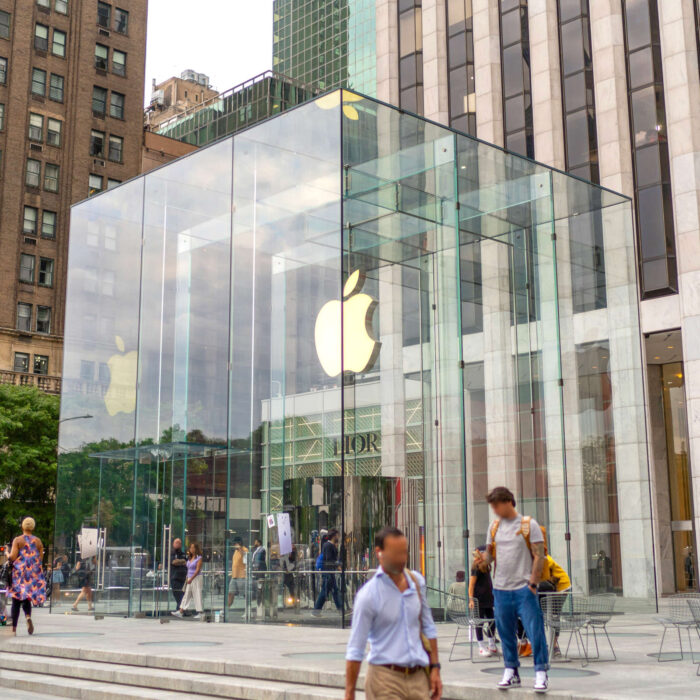
Apple’s organizational culture (business culture) reflects the business philosophy, core values, beliefs, and workplace behaviors. This company culture facilitates Apple’s mission and vision fulfillment under Tim Cook’s leadership. Apple’s work culture motivates employees for competitive innovation.
Apple’s company culture strengthens competitive advantages against the consumer electronics and online services of Google (Alphabet), Samsung, Microsoft, Amazon, and Sony, as well as Apple TV Plus competitors, like the video streaming services of Disney, Facebook (Meta), and Netflix.
Competitors impose the strong external force illustrated in the Five Forces analysis of Apple. The company’s organizational culture reinforces business competitiveness through human resources.
Apple’s Culture Type and Traits
Apple has an organizational culture for creative innovation. Innovation is a success factor. The following are the main characteristics of Apple’s culture:
- Top-notch excellence
- Creativity
- Innovation
- Secrecy
- Moderate combativeness
Apple’s cultural features focus on innovation involving workers’ creativity and a mindset that challenges conventions and standards, such as in consumer electronics design. The company depends on cultural support and coherence that determine IT business competitiveness and industry leadership for technological innovation and product development.
Top-notch Excellence. Apple’s organizational culture comes with a human resource policy of hiring only the best of the best in the labor market. Steve Jobs was known to fire employees who did not meet his expectations.
This tradition continues under Tim Cook. Such a workplace tradition maintains and reinforces a company culture that promotes, appreciates, and expects top-notch excellence among Apple’s employees.
This cultural trait of excellence is institutionalized in Apple’s organization. For example, the company has programs that recognize and reward excellence among workers in software design and hardware engineering.
Excellence is emphasized as a critical success factor in the business, especially in product design and development, which is a major strategy established through Apple’s competitive strategy and growth strategies.
Creativity. This cultural trait pertains to creating new ideas that help improve the technology business and its products. Apple’s management favors creativity among employees’ knowledge, skills, and abilities.
This characteristic of the work culture enables the company to ensure sufficient creativity, especially among employees involved in consumer electronics product design and development processes. Creativity is observable in the design and features of iPhones, Macs, iPads, and other products included in Apple’s marketing mix (4Ps).
Along with creativity, originality is also culturally emphasized as a way of maximizing the company’s intellectual properties, such as patents for new mobile devices. In this regard, the organizational culture helps maintain Apple’s competitiveness in meeting trends in customers’ expectations and preferences.
Innovation. Apple’s company culture supports rapid innovation. The company is frequently appraised as one of the most technologically innovative in the world. Based on this cultural trait, Apple trains and motivates its employees to innovate in terms of individual work performance and idea contributions for product development, design, and other business areas.
Rapid innovation facilitated through this work culture is at the heart of Apple’s operations management. Rapid innovation ensures that the company continues to introduce new products that are profitable and attractive to target customers in the global consumer electronics and Internet services market.

Secrecy. Apple has a secretive organizational culture. This cultural characteristic defines the MacBook maker’s human resource development and management practices. Secrecy in Apple’s culture is beneficial in the fast-paced and technologically innovative industry involving tough competition.
Secrecy is a part of Apple’s human resource management strategy to prevent theft of proprietary information or intellectual property, such as designs for the next generations of iPhones, iPads, and MacBooks.
Secrecy is a strategic management approach that enables Apple Inc. to maximize its leading edge against competitors. Through this company culture, employees are motivated and expected to keep new IT and consumer electronics information within the business organization.
This cultural trait is reinforced through Apple’s organizational structure (business structure) and related policies, rules, and employment contracts that prohibit the disclosure of information, such as technological breakthroughs. In this context, Apple’s work culture helps protect the business from corporate espionage and the negative effects of employee poaching.
Moderate Combativeness. Apple’s company culture has moderate combativeness. This trait is linked to Steve Jobs and his combative approach to leadership. He was known to randomly challenge employees to ensure that they have what it takes to work at Apple.
Today, under Tim Cook’s leadership, the company has been changing its corporate culture to a more sociable and a less combative one. Nonetheless, combativeness remains a major influence in the technology business. Apple’s business culture exhibits a moderate degree of combativeness that presents challenges that motivate employees to enhance their output.
Apple’s Organizational Culture: Advantages, Disadvantages, Recommendations
Advantages and Benefits. The combination of top-notch excellence, creativity, and innovation in Apple’s organizational culture supports the company’s competitive advantages in innovation and product design, especially in consumer electronics.
Through technological innovation and excellence in product design, this company culture also further strengthens the brand, which is one of the key business strengths shown in the SWOT analysis of Apple Inc.
Creativity and excellence are especially important in Apple’s rapid innovation processes for continuous competitiveness and business development despite aggressive competition with Samsung and other firms. These cultural characteristics empower the company’s human resources to stay ahead of competitors.
Drawbacks and Weaknesses. Apple’s corporate culture brings challenges because of the emphasis on secrecy and the moderate degree of combativeness. An atmosphere of secrecy can limit rapport among workers, while moderate combativeness has the potential to limit or reduce employees’ morale. These cultural issues could reduce business effectiveness and increase employee turnover.
Apple can address such drawbacks and weaknesses by modifying its organizational culture to reduce combativeness, but not necessarily remove it. This recommendation focuses on reducing the disadvantages of combativeness, without eliminating the benefits of combative approaches in innovative capabilities in IT business.
Also, Apple can integrate new cultural traits to keep the business relevant, given trends and changes in information technology, cloud services, digital content distribution, and consumer electronics.
References
- Chen, Z. (2024, September). Business Strategy Analysis: Evidence on Apple Inc. In Proceedings of the 2024 4th International Conference on Enterprise Management and Economic Development (ICEMED 2024) (p. 104). Springer Nature.
- Kucharska, W., & Karwowska, E. (2025). Company culture matters! Knowledge-driven companies’ way to innovations and sustainability. Social Sciences & Humanities Open, 11, 101268.
- Life at Apple.
- O’Reilly, C., Cao, X., & Sull, D. (2025). CEO personality: The cornerstone of organizational culture? Group & Organization Management, 50(1), 82-118.
- Sumarjo, W., Haerofiatna, H., & Wahyudi, W. (2025). The role of organizational culture in improving employee performance through organizational commitment. Journal of Management Science (JMAS), 8(1), 21-28.
- Work at Apple.